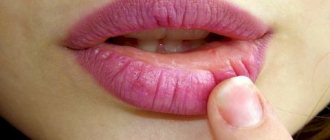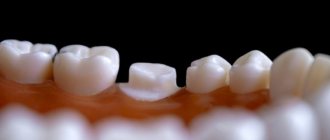Tooth enamel is the hardest tissue in the human body. Up to 90% of calcium reserves are concentrated here. However, cosmetic dentistry regularly deals with defects in this tissue. The fact is that hardness and ductility are different things. With impressive hardness levels, enamel is a fragile material that easily chips and cracks.
The situation gets worse if the enamel is weak. Temperature changes, chronic diseases, blows - and then the tooth breaks off. The situation is unpleasant, and in the long term it is also fraught with caries. Through the crack, bacteria penetrate directly into the tooth, to the pulp, which means that caries will quickly develop into pulpitis. In general, a chipped tooth is a reason to see a doctor, and quickly.
So, what to do if a tooth chips?
- Rinse your mouth with any suitable antiseptic or water to protect the tooth from bacteria and food debris.
- If there is bleeding, apply a tampon with hydrogen peroxide or a hemostatic sponge.
- Apply cold externally to prevent swelling from developing.
- If the pain is very severe, take a pain reliever.
- If a tooth chips on the street, try to rinse your mouth with drinking water (mineral water is also suitable, but not sugary drinks). Other measures can be postponed to your home or the nearest pharmacy.
After that, call your dentist. There is no point in going to emergency rooms - they will simply pull out the affected tooth, especially if a child’s baby tooth has chipped off. You need to eliminate the defect without unnecessary sacrifices.
Fortunately, there are ways to quickly restore a tooth, even if it is severely damaged. There is a whole direction - aesthetic restoration of teeth, it deals with both acquired and congenital defects. Today, restorative dentists work wonders to transform small and uneven teeth into a Hollywood smile. This direction is developed both in pediatric and adult dentistry.
Types of chipped teeth
Restoration methods depend on the damage. Dentists distinguish the following types of chipped teeth:
- Incomplete. A barely noticeable crack appears on the enamel, and the rest of the tooth is not affected. The easiest case, which requires purely aesthetic restoration.
- Enamel chip. If a small piece breaks off from a tooth, most likely only the enamel is damaged. If measures are taken quickly, the deep layers of the tooth will not have time to collapse either.
- Dentin chipping. This layer is located under the enamel, inferior to it in hardness, but reliably protects the nerve and pulp. If dentin is damaged, the tooth usually does not hurt; at most, it reacts to acids and cold.
- Chip exposing the pulp. If a tooth is severely cracked, its darker part is visible, and the person is in pain, this means that the pulp, the most sensitive part of the tooth, is damaged. This is where the nerve and blood vessels are located, so bleeding is common. If the pulp is chipped, you need to make an appointment with a doctor as soon as possible. However, when half a tooth chips off, people usually do not postpone the visit.
What to do if your front tooth chips
Dental defects are always unpleasant, but it’s especially annoying if they are visible. Dentists call visible teeth the “smile zone” and pay special attention to its condition. So, what to do if your front tooth chips? The doctor will suggest the following restoration methods:
- Surface enamel cracks are simply sanded down. You can also saturate the tissue with minerals to speed up recovery. The problem is solved in one visit.
- If the tooth is cracked down to the dentin, grinding is not enough. The crack can be repaired with special materials that resemble a filling. The color is selected to match the enamel. The material is applied layer by layer, illuminated with a special lamp and finally sanded to perfect smoothness.
- If half a tooth is chipped off, it can be restored with a filling or dentures. Are used:
- veneers - decorative overlays on the tooth surface;
- inlays are metal-ceramic structures that replace part of a tooth;
- Crowns are structures that replace the entire visible part of a tooth.
Aesthetic dentistry tries to preserve the surviving tissue as much as possible, since the choice of methods and materials is very wide. But when a tooth is almost completely destroyed, it may be easier to remove it and install a crown or implant.
Baby tooth chipped off
Everyone knows that chipped permanent teeth need to be repaired as soon as possible. However, pediatric dentistry often deals with damage to primary teeth. Children who experience the world by taste are especially often affected: it is enough to pull a stone, a plastic toy into their mouth, or simply fall, and the enamel may not withstand it.
First aid for a child whose tooth has chipped is the same as for an adult:
- Calm down, console.
- Give water to rinse your mouth.
- If necessary, stop the bleeding with peroxide or a sponge.
- Apply cold to reduce swelling.
- If the baby complains of pain, give the usual painkiller.
- Call pediatric dentistry in Krasnoyarsk, explain the situation and make an appointment.
The child will be examined by a doctor and sent for an x-ray to find out whether the soft tissues of the tooth have been damaged. The easiest case is if there is a chip on a tooth that was loose even before the injury. In this case, it is simply removed. But if the tooth holds tightly, treatment is needed. Otherwise, bacteria will penetrate through the crack, and this not only threatens the destruction of the baby tooth, but can also lead to problems with permanent ones.
At Mira Dentistry, we know how to find an approach to children whose baby teeth have broken off, even very young ones. After all, choosing a treatment is not difficult; it is more difficult to get a frightened child to trust the doctor. Correction methods are generally the same as for adults: polishing, remineralization, restoration with a filling.
Tooth fracture without pulp exposure
In dentistry, a fracture is understood as an injury in which the enamel prisms diverge from each other, and part of the dental tissue is lost. In the event of a fracture, the prisms are not only separated, but also parts of them are lost. The fracture can also pass through dentin, but in this case the dental pulp remains intact.
X-ray
When conducting radiographic studies, if a child’s tooth has chipped, it is not difficult to determine serious damage, while it is almost impossible to recognize a crack in the picture.
Treatment and postoperative monitoring
For small chips, grinding down the enamel is possible, but for more extensive damage, a composite tooth restoration may be required.
In cases where the patient was able to save the chipped tooth fragment, it is possible to fix it in place using adhesive bonding techniques. The technology for performing the work is fully consistent with the methods used by dentists when providing services for complete dental restoration with composite materials.
Recent laboratory studies have proven that with the use of modern adhesive materials, it is possible to restore the reliability of the connection of the broken area of the tooth, corresponding to the intact tooth.
To increase the aesthetic appeal of the tooth being restored, it is recommended to first create a bevel of small width from composites around the entire perimeter of the broken area, reaching 1-2 mm depending on the specific situation.
Forecasting
After recovery, the patient is required to visit the dentist 2 and 12 months after the procedure. In cases where tooth sensitivity remains within normal limits, there is no need for further observations. The risks of complications due to the pulp are minimal.
Prevention of chipped teeth
The golden rule of medicine: prevention is easier than cure. Prevention of chipped teeth requires:
- Avoid mechanical damage. Those at risk include fans of seeds and hard nuts, as well as those who like to chew pens and pencils.
- Avoid temperature changes in food. Ice cream with coffee is delicious, but if you regularly treat yourself to a combination of hot and cold, you can end up with microcracks in your enamel and an unscheduled visit to the dentist.
- Teenagers and adults: use protective mouthguards when playing traumatic sports. We are talking about boxing and other types of wrestling, hockey, rugby, handball - all where there is a high risk of getting hit in the face and, consequently, a chipped tooth.
- Eat properly. Lack of calcium is the most obvious cause of weakened enamel.
- Monitor the health. Many chronic diseases affect the condition of teeth. With diabetes, gastrointestinal disorders, and endocrine problems, the risk of getting a chipped tooth increases.
And, of course, it is worth monitoring your oral hygiene and regularly visiting adult or pediatric dentistry in order to notice and treat problems with enamel in time.
What experts advise for prevention
As in the case of any other pathological conditions, it is always better to prevent unpleasant consequences than to later engage in long and costly, and sometimes quite painful, treatment. To reduce the risk of damage and destruction of children's primary incisors and molars, it is necessary from an early age to teach the child to take a responsible approach to oral care, brush his teeth every morning and evening, and follow all basic hygiene rules.
It is worth keeping a close eye on your baby while he is playing. Try to exclude all traumatic factors. Later, if the child begins to engage in traumatic sports, he should be given an individual protective mouthguard - this service is provided by many modern dentists.
It is worth keeping a close eye on your baby while he is playing.
But finally, in no case should you ignore any pathological changes in the oral cavity, even if there are only temporary baby incisors and molars. If there is a clear malocclusion, orthodontic treatment should be started promptly. If caries and inflammatory processes develop, immediately show the child to a specialist. Parents need to remember that any advanced dental diseases can easily damage the buds of permanent teeth, which will inevitably affect their condition and health in the future.
1Eradze E.P., Osipov G.A. Modern methods of treating acute dental trauma in children, 2001.
How much does it cost to fix a chipped tooth?
It happens that people do not seek help because they think that dental restoration is very expensive. In fact, it is easier and cheaper to immediately “fix” a chipped tooth than to wait for bacteria to penetrate through the crack and have to treat pulpitis. Moreover, all our services are available in installments.
In Mira clinics, prices for correction of a chipped tooth start at 2,000 rubles. — this is how much it costs to restore the edges of the front teeth. The final cost of treatment depends on the volume. You can call the clinic and we will tell you how much it costs to fix a chipped tooth in your case. But it’s better, of course, to make an appointment for an inspection - only after assessing the damage can you give an exact price. “Mira” is your dentistry, Krasnoyarsk is not in vain turning to us!
Tooth injury
Is it possible to restore a damaged tooth?
Any injury to a child is perceived very painfully by parents, and injury to the central teeth causes very intense feelings for all family members. And this is understandable. Pain, possible complications, violations of the aesthetics of a smile - all these worries of parents are understandable, but in vain. Modern dentistry copes well with this problem. Direct restoration is used to restore the aesthetics and function of a damaged tooth.
Why are dental injuries so common in children and what can this lead to?
Children usually receive injuries to their front teeth as a result of falling or hitting hard objects. The most common injury (67.8% of cases) is a fracture of the crown of the central teeth of the upper jaw. This is due to the fact that a common bite is in which the upper central teeth overlap the lower ones, and therefore they take the entire blow. Tooth trauma leads not only to disruption of its integrity, but also to dysfunction, damage to the root and soft tissues.
What period is most dangerous for such injuries?
In young children, acute dental trauma most often occurs at the age of 2.5-3 years. This is explained by the baby’s curiosity and lack of a sense of danger. The peak of injury occurs at 8-10 years of age in the mixed dentition. This is due to the mobility of children, the beginning of active sports, and the lack of proper control over children’s behavior by adults. The situation in this age group is complicated by the fact that the tooth root is not formed. The attending physician faces the task of creating favorable conditions for preserving the vitality of the pulp so that the formation of the tooth root is successfully completed.
What to do if a child breaks a tooth?
First of all, you must immediately seek help from a dental facility that has x-ray equipment. This is due to the fact that it is possible to qualitatively determine the depth of the injury and the location of the fracture of the tooth and bone tissue of the jaws, if any, or to exclude their presence, only with the help of x-rays. Of course, the three-dimensional dental computed tomograph 3D has undeniable capabilities in the field of radiology, which makes it possible to examine the dental system in all planes and identify even hidden damage.
Is there such a tomograph in Volgograd?
Yes, we have it in our clinic. With the help of the “>Morita” 3D tomograph, a few minutes are now enough in any clinical situation to see comprehensive information about the problem. The tomograph is completely safe for patients and medical personnel. The level of its radiation for the human body is 6-10 times less compared to X-ray devices of the previous generation. We accept patients from all dental clinics in the region for examination.
Is it possible to restore a broken tooth to its original form?
Certainly. After the treatment related to the preservation of the tooth, the question will arise about restoring its aesthetics and function. Today, new technologies have replaced the stamped steel crown. Currently, thanks to the advent of dental filling materials with a preventive effect, good adhesion and a wide range of light, it has become possible to restore damaged crowns of primary and permanent teeth using the direct restoration method.
What is the direct restoration method?
Direct restoration is a dental technique by which missing tooth tissue is restored layer by layer with polymer restorative or photopolymerizing composites. These restorations restore the shape, function and aesthetic appearance of the tooth. At the same time, it is very important to choose the right filling material that meets the requirements and meets expectations for the final results of the work.
How successful is this type of work in your clinic?
The doctors at the Lazur dental clinic have accumulated many years of experience in treating children with dental injuries of varying complexity using the direct restoration method. And since 1998, our clinic has completely switched to Swiss materials. With a variety of shades in the color palette, you can choose a color for even the most complex clinical case. It is easy to predict color density and transparency, to repeat the anatomy of tooth tissue. This filling material was the first to use a matrix, which in its optical properties and characteristics is close to natural tooth enamel and is capable of partially refracting, partially reflecting, but most importantly, transmitting light through itself. We immediately appreciated this unique optical ability to make the filling-tooth boundary invisible.
Is it possible to avoid the effect of “missing” teeth in special lighting, for example, at a disco or with a camera flash?
Yes, indeed, this happens - teeth seem invisible in unnatural lighting. This occurs if a material that does not have fluorescent properties was used for restoration. The filling materials used in our clinic provide natural color and allow you to hide the tooth restoration under non-standard lighting conditions. Today, patients are very demanding about the aesthetics and naturalness of reconstructions; “invisibility” of the restoration is becoming a prerequisite. And our task is to fulfill these conditions.
Does a child with a restored tooth need to be seen by a doctor?
Yes need. All cases of dental trauma in children are monitored. Young patients visit their doctors at regular intervals, which allows them to track long-term treatment results.











